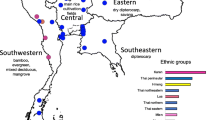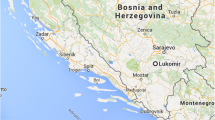Abstract
Medical Ethnobotany of the Yucatec Maya: Healers’ Consensus as a Quantitative Criterion. Economic Botany 53(2):144–160, 1999. There is an urgent need to obtain information on the relative importance of a taxon used medicinally as compared to others within the same culture. This was achieved through a documentation of the current indigenous medical uses of 320 species in three Yucatec Maya communities during 18 months of fieldwork. The 1549 individual reports documented were divided into nine groups, which classify indigenous uses. The frequency of usage of the individual plants reported was employed in the analysis of the ethnobotanical importance of the respective taxa. Species cited more frequently in a group of indigenous uses are regarded to be of greater ethnobotanical importance than those cited only by a few informants. In order to obtain information on possible biological, pharmacological and toxicological effects of some particularly important species, the scientific literature on these taxa was evaluated systematically. The study is the basis for phytochemical and pharmacological evaluations of the traditional uses.
Resumen
Se considera esencial la documentación de la importancia relativa que un taxon de uso medicinal tiene, en comparación con otros taxones dentro de una misma cultura. Con este propósito se realizó un estudio etnobotánico de 18 meses, investigando el uso de 320 especies en très comunidades Mayas del Estado de Yucatán (México). Se documentaron 1549 usos indigenas, que se clasificaron en 9 grupos. Se utilizó el numero de usos indígenas para determinar la importancia relativa de cada especie; así, las especies medicinales que fueron citadas con mayor frecuencia se consideran las de mayor importancia, mientras que las especies citadas con menor frecuencia son las de menor importancia. Para evaluar los usos indigenas se obtuvo información sobre efectos biológicos, farmacológicos y toxicológicos de las especies, através de una revisión sistemática de la literatura científica. Este estudio es la base para la selección de plantas que se evaluarán en estudios fitoquímicos y farmacológicos.
Similar content being viewed by others
Literature Cited
Aguilar, A., J. R. Camacho, S. Chino, P. Jácquez, and M. E. Lopez. 1994. Herbario medicinal del Institute Mexicano del Seguro Social. Instituto Mexicano del Seguro Social. México, D.F.
Alcorn, J. B. 1984. Huastec Mayan Ethnobotany. University of Texas Press, Austin.
Argueta Villamar, A. (coordinator) 1994. Atlas de las plantas de la medicina tradicional Mexicana. 3 Vols. Institute National Indigenista, México, D.F.
Arnasonn, Th., F. Uck, J. Lambert, and R. Hebda. 1980. Maya medicinal plants of San José Succotz, Belize. Journal of Ethnopharmacology 2:345–364.
Barrera Marín, A., A. Barrera Vázquez, and R. M. López Franco. 1976. Nomenclature etnobotanica Maya. Una interpretatición taxonómica. Secretaria de Educación Publica (SEP). Centro Regional del Sureste, Mérida.
Berlin, B., and E. A. Berlin. 1996. Medical Ethnobiology of the Highland Maya of Chiapas, Mexico. Princeton University Press, Princeton, NJ.
Berlin, E. A., and V. M. Jara. 1993. Me’Winik: Discovery of the biomedical equivalance for a Maya ethnomedical syndrome. Social Science and Medicine 37:671–678.
Borgesdel Castillo,J., M. T. Manresa F., F. Rodriguez L., and P. Vasquez B. 1981. Juanislamin and 2,3-epoxy-juanislamin, two new sesquiterpenic lactones fromCalea urticifolia. Journal of Natural Products 44:348–350.
Bork, P. M., M. L. Schmitz, C. Weimann, M. Kist, and M. Heinrich. 1996. Nahua indian medicinal plants (Mexico): Inhibitory activity on NF-κB as an anti-inflammatory model and antibacterial effects. Phytomedicine 3(3):263–269.
——,M. Kuhnt, C. Escher, and M. Heinrich. 1997. Sesquiterpene Lactone Containing Mexican Indian Medicinal Plants and pure Sesquiterpene Lactones as Potent Inhibitors of Transcription Factor κB (NF-κB). FEBS Letters 402(1):85–90.
Bye, R. 1993. The role of humans in the diversification of plants in Mexico. Pages 707–731in T. P. Ramamoorthy, R. Bye, A. Lot and J. Fa, eds., Biological Diversity in Mexico: Origins and Distribution. Oxford University Press, Oxford.
Cáceres, A., A. V. Alvarez, A. E. Ovando, and B. S. Samayo. 1991. Plants used in Guatemala for the treatment of respiratory diseases. Journal of Ethnopharmacology 31:193–208.
Calzado, F., R. Mata, R. Bye, and E. Linares. 1990. A retrochalcone fromAnredera scandens. Phytochemistry 29:2737–2738.
Cardeña Vázquez, I. 1985. Medicina tradicional en Chikindzonot, Yucatán. Cuadernos de Trabajo, Yucatán No. 10. Secretaría de Educación Publica (SEP), Direction General der Culturas Populares, Mexico, D.F.
Comerford, S. C. 1996. Medicinal plants of two Mayan healers from San Andrés, Petén, Guatemala. Economic Botany 50:327–336.
Duch, J. G. 1988. La conformation teritorial del estado de Yucatán. Universidad Autónoma Chapingo, Centro Regional de la Peninsula de Yucatán, México, D.F.
Etkin, N., ed. 1994. Eating on the Wild Side. The Pharmacologic, Ecologie and Social Implications of Using Noncultigens. University of Arizona Press, Tucson.
Falk, U. 1992. Kladistische und chemotaxonomische Beitraege zur Stellung der Unterfamilie Caryopte ridoideae Briq. innerhalb des Verbenaceae-Lamiaceae Komplexes. Dissertation. University of Freiburg, Germany.
Frei, B., O. Sticher, and M. Heinrich. 1998. Zapotec Use of Medicinal Plants: Documentation and Evaluation. Journal of Ethnopharmacology: 62:149–165.
Friedman, J., Z. Yaniv, A. Dafni, and D. Dalewitch. 1986. A preliminary classification of the healing potential of medicinal plants. Journal of Ethnopharmacology 16:275–287.
Giron, L. M., V. Freire, A. Alonzo, and A. Cáceres. 1991. Ethnobotanical survey of the medicinal flora used by the caribs of Guatemala. Journal of Ethnopharmacology 34:173–188.
Glasby, J. S. 1991. Dictionary of Plants Containing Secondary Metabolites. Taylor & Francis, London.
Haensel, R., K. Keller, H. Rimpler, and G. Schneider. 1992–1994. Hagers Handbuch der Pharmazeutischen Praxis. Drogen. Springer-Verlag, Berlin.
Hegnauer, R. 1962-1996. Chemotaxonomie der Pflanzen. 14 Vols. Birkhaeuser Verlag, Basel, Boston, Berlin.
Heinrich, M. 1989. Ethnobotanik der Tieflandmixe (Oaxaca, Mexico) und phytochemische Untersuchung vonCapraria biflora L. (Scrophulariaceae). Dissertationes Botanicae No. 144. J. Cramer, Berlin, Stuttgart.
— 1992. Economic botany of American Labiatae. Pages 475–488in R. M. Harley and T. Reynolds, eds., Advances in Labiatae Science. Richmond. Royal Botanical Gardens, Kew.
— 1996. Ethnobotany of Mexican Compositae: An analysis of historical and modern sources. Pages 475–503in D. J. N. Hind, Editor-in Chief, Proceedings of the International Compositae Conference, Kew, 1994. Vol. 2. Biology and Utilization (vol eds. P.D.S. Caligaria and D.J.N. Hind). Richmond (UK). Royal Botanical Gardens, Kew.
-. 1998. Indigenous concepts of medicinal plants in Oaxaca. Ecology of Food and Nutrition.
—,H. Rimpler, and N. Antonio B. 1992. Indigenous phytotherapy of gastrointestinal disorders in a Mixe lowland community. Journal of Ethnophar-macology 36:63–80.
-,A. Ankli, B. Frei, C. Weimann, and O. Sti-cher. n.d. Comparitive Ethnobotany of four Mexican Indian Groups: An Analysis. Social Science and Medicine: submitted.
Herrera Castro, N. D. 1994. Los huertos familiares Mayas en el oriente de Yucatán. Etnoflora Yuca-tenense No 9. Univerisdad de Yucatán, Mérida.
Hoer, M., H. Rimpler, and M. Heinrich. 1995. Inhibition of intestinal chloride secretion by proan-thocyanidins fromGuazuma ulmifolia. Planta me-dica 61:208–212.
Humphries, S. 1993. The intensification of traditional agriculture among Yucatec Maya farmers. Human Organization 21:87–102.
INEGI. 1993. Anuario estadistico del Estado de Yucatán. XI Censo general de población y vivienda, 1990. INEGI (Instituto Nacional de Estadistica del Estado de Yucatán). Mérida.
Jimenez, A., R. Mata, B. Lotina-Henssen, A.L. Anaya L., and L. Velasco I. 1996. Phytogrowth-Inhib-itory Compounds fromMalmea depressa. Journal of Natural Products 59:202–204.
Johns, T. 1990. With Bitter Herbs They Shall Eat It. University of Arizona Press, Tucson.
—,J. O. Kokwar, and E. K. Kimanani. 1990. Herbal remedies of Luo of Siaya District, Kenya: Establishing quantitative criteria for consensus. Economic Botany 44:369–381.
Kato, T., B. Frei, M. Heinrich, and O. Sticher. 1996. Antibacterial hydroperoxysterols fromXanthosoma robustum. Phytochemistry 41:1191–1195.
Khalid, S. A. 1983. Chemistry of the Burseraceae. Pages 281–299in Peter G. Waterman and M.F. Grundon, eds., Chemistry and Chemical Taxonomy of the Rutales. Academic Press, London.
Koehler, U. 1990. Altamerikanistik. D. Reimer, Berlin.
Kuhnt M., A. Proebstle, H. Rimpler, R. Bauer, and M. Heinrich. 1995. Biological and pharmacological activities and further constituents ofHyptis verticillata. Planta medica 61(3):227–232.
List, P. H., and L. Hoerhammer, eds. 1969–1980. Hagers Handbuch der Pharmazeutischen Praxis. 4th. ed. 8 vols. Springer-Verlag, Berlin.
Lopez Austin, A., and C. Viesca Trevino. 1984. La Historia general de la medicina en México. Tomo I: México antiguo. Universidad Nacional Autónoma de México, México, D.F.
Mendita, R. M., and S. del Arno R. 1981. Plantas medicinales del Estado de Yucatán. INIREP (Ins tiuto Nacional de Investigaciones sobre Recursos Bioticos). Xalapa (México).
Moerman, D. E. 1996. An analysis of the food plants and drug plants of native North America. Journal of Ethnopharmacology 52:1–22.
Morales, M. A., J. Tortoriello, M. Meckes, D. Paz, and X. Lozoya. 1994. Calcium-antagonist effect of quercetin and its relation with the spasmolytic properties ofPsidium guajava L. Archives of Medical Research (México, D.E) 25:17–21.
Morton, J. F. 1981. Atlas of Medicinal Plants of Middle America, Bahamas to Yucatan. C. Thomas, Springfield, IL.
Okuda, T., Y. Takashi, T. Hatano, K. Yazaki, Y. Ikegami, and T. Shingu. 1987. Guavins A, C and D fromPsidium guajava. Chemical and Pharmaceutical Bulletin 35:443–446.
Orosa Díaz, J. 1991. Historia de Yucatán. 22a reim-presión. Ediciones de la Universidad Autónoma de Yucatán. Mérida.
Pfeiler, B. 1995. Zur Prosodie des Spanischen in Yucatán, Mexiko. Pages 119–134in Klaus Zimmer-mann, ed., Lenguas en contacta en Hispanoamérica. Vervuert, Frankfurt.
Pharmacopoea Helveticae 8. 1997. Eidgenšssisches Departement des Innern, Eidgenšssische Drucksachen-und Materialzentrale. Bern.
Phillips, O. L. 1996. Some quantitative methods for analyzing ethnobotanical knowledge. Pages 171–197in M. N. Alexiades, ed., Selected Guidelines for Ethnobotanical Research. A Field Manual. Advances in Economic Botany (New York) 10.
Pulido Salas, Ma. T., and L. Serralta Peraza. 1993. Lista anotada de las Plantas medicinales de uso actual en el estado de Quintana Roo, México. Centro de Investigaciones de Quintana Roo. Chetumal (México).
Redfield, R., and A. Villa Rojas. 1990 [orig. 1934]. Chan Kom: A Maya Village. Waveland Press, Inc., Illinois.
Robineau, L., and D. D. Soejarto. 1996. Tramil: A research project on the medicinal plant resources of the Caribbean. Pages 317–325in M. J. Balick, E. Elisabetsky and S. A. Laird, eds., Medicinal Resources of the Tropical Forests. Columbia University Press, New York.
Rodriguez-Hahn, L., B. Esqivel, and J. Cárdenas. 1995. Neo-clerodane diterpenoids from AmericanSalvia species. Pages 311–332in J. T. Arnason, R. Mata and J. T. Romero, eds., Phytochemistry of Medicinal Plants. Recent Advances in Phytochemistry 29.
Salvador Flores, J., and L. Espejel Carvajal. 1994. Tipos de vegetatición de la peninsula de Etnoflora Yucatanense, Fasiculo 3. Universidad Autónoma de Yucatán, Mérida.
Scholz, E., M. Heinrich, and D. Hunkler. 1994. Caffeoylquinic acids and some biological activities ofPluchea symphytifolia. Planta medica 60:360–364.
Simpol, L. R., H. Otsuka, K. Ohtani, R. Kasai, and K. Yamasaki. 1994. Nitrile glucosides and rosmarinic Acid, the histamine inhibitor fromEhretia philippinensis. Phytochemistry 36:91–95.
Sosa, V., J. Salvador Flores, V. Rico-Gray, R. Lira, and J. J. Ortiz. 1985. Lista florística y sinonimia Maya. Instituto Nacional de Investigaciones sobre Recursos Bioticos (INIREB), Xalapa (México). Etnoflora Yucatenense fas. 1
Standley, J. L. 1930. Flora of Yucatan. Field Museum of Natural History, Chicago, Publication No. 279, Botanical Series Vol. 3 No. 3.
Steggerda, M., and B. Korsch. 1943. Remedies for diseases prescribed by Maya Indian herb-doctors. Bulletin of the History of Medicine 13:54–82.
Suarez, A., G. Ulate, and J. F. Ciccio 1997. Cardiovascular effects of ethanolic and aqueous extracts ofPimenta dioica in Sprague-Dawley rats. Journal of Ethnopharmacology 55:104–111.
Terán, S., and C.H. Rasmussen.1994. La milpa de los Mayas. Universidad de Yucatán. Mérida.
Terreaux, C., M. Maillard, H. Stoeckli-Evans, M. P. Gupta, K. R. Downum, J. M. E. Quirke, and K. Hostettmann 1995. Structure revision of a furanocoumarin fromDorstenia contrajerva. Phytochemistry 39:645–647.
Tomas Barberan, F. A., S. Z. Husein, and M. I. Gil. 1988. The distribution of methylated flavones in the Lamiaceae. Chemical Systematics and Ecology 16:43–46.
van der Geest, S., S. R. Reynolds, and A. Harden. 1996. The anthropology of pharmaceuticals: A biographical approach. Annual Review of Anthropology 25:153–178.
Villa Rojas, A. 1981. Terapéutica tradicional y medicina moderna entre los Mayas de Yucatán. Anales de Antropologia (México, D.F.) 18(2): 13–28.
Weimann, C, and M. Heinrich. 1997. Indigenous medicinal plants in Mexico: The example of the Nahua (Sierra de Zonglicia). Botanica Acta 110: 62–72.
Author information
Authors and Affiliations
Corresponding author
Rights and permissions
About this article
Cite this article
Ankli, A., Sticher, O. & Heinrich, M. Medical ethnobotany of the Yucatec Maya: Healers’ consensus as a quantitative criterion. Econ Bot 53, 144–160 (1999). https://doi.org/10.1007/BF02866493
Received:
Accepted:
Issue Date:
DOI: https://doi.org/10.1007/BF02866493




